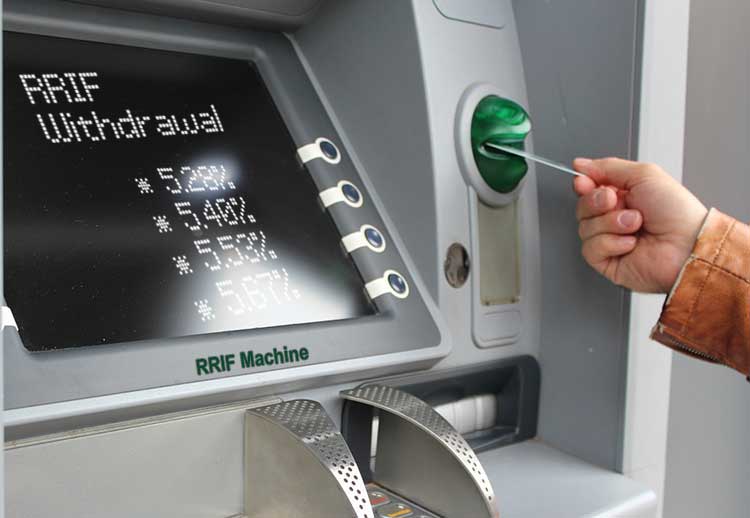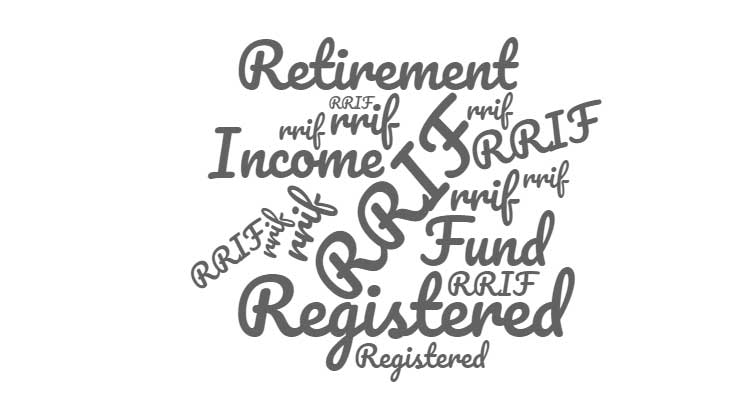RRIF Calculator: Calculate Your RRIF Minimum Withdrawal Rate (2020)
IMPORTANT NEWS: The federal government is reducing the minimum withdrawal rate from RRIFs in 2020 by 25%.

Government of Canada’s COVID-19 Economic Response Plan For Seniors
On March 18, 2020, the Prime Minister announced a new set of economic measures. Reducing required minimum withdrawals from Registered Retirement Income Funds (RRIFs) by 25% for 2020, in recognition of volatile market conditions and their impact on many seniors’ retirement savings. This will provide flexibility to seniors that are concerned that they may be required to liquidate their RRIF assets to meet minimum withdrawal requirements. Similar rules would apply to individuals receiving variable benefit payments under a defined contribution Registered Pension Plan.
Calculating Your RRIF Minimum Withdrawal Rate
Interested in knowing your RRIF minimum withdrawal rate? Well, you’ve definitely come to the right place!
In this article we are going tell you about various RRIF withdrawal calculators that are available online but we are also going to …
Explain what a RRIF is as well as how to determine your minimum withdrawal rate ( should these RRIF minimums be eliminated?).
We are also going to cover a lot more information about RRIFs, including RRIF rules of withdrawal, RRIF strategies, RRIF fees and more, so that you can be fully informed about all of your options moving forward and can have the Canadian dream retirement you've always wanted.
Before we move on to determining your minimum RRIF withdrawal formula and to discussing RRIF payment calculators let’s quickly take a look at some retirement planning basics that everyone should keep in mind. So let’s get started.
RRIF Factors: Setting Retirement Goals
& Predicting Needs
The first step in successful retirement planning using your RRIF is a realistic assessment of your goals for retirement. When thinking about the size of withdrawals you are going to be making from your RRIF funds some questions to ask yourself up front include the following:
What Kind of Health will I be in?

Of course, this is largely speculative, but if you’re someone who spends a lot of time on the mend, you must plan for a major expense: the increased medical needs that come with advanced age and its attendant ills. Of course, this will apply in general to most older people, but, assessing your health frankly, you should be able to get some idea of just how much care will be in your future.
Yet healthy seniors aren’t completely off the hook: those who’ve never been sick a day in their life will usually live longer, which extends the number of years they’ll have living off their RRIF payments.
Is Retirement Going to be a Playland … or
a Quiet Rest Period?

For some people, ideas of retirement revolve around foreign travel, fancy restaurants, and a round of golf each day. For others, the ideal retirement means holidays spent with children and grandchildren, and a low-key, contemplative lifestyle. If you’re part of Group A, you’ll need the resources to do more than just get by. A fast-paced, luxury retirement will (of course) burn through that RRIF nest egg pretty quick.
Most retired people end up spending quite a bit less than they did while they were working, but the expenses involved in frequent travel or moves to sunny locales can quickly run a retiree into the red. It’s important to get a firm handle on what kind of retirement lifestyle you desire for your golden years. Those who seek only peace and quiet will need less, those who want to do everything they never had time to do before will need more. A lot more.
How Much of an Inheritance will I Leave?
For some particularly crotchety old-timers, the easy answer is “Bus fare and no more!” For most people, however, the answer is as much as possible. If you want to leave a sizable chunk of estate to your children, secure your grandchildren’s college fees, or just keep your favorite tabby in gourmet cat food, you’re going to need to plan carefully.
Tax and inheritance laws, and tools like trusts, must be understood in order to properly preserve your estate for any heirs. You should also understand the benefits of RRIFs versus annuities, RRIF withdrawal rules, RRIF conversion rules and more.
Do I Want (Need) to Work During Retirement?

For some people, the very sound of a “working retirement” is like fingernails on a chalkboard. Yet, this apparent oxymoron has been an increasingly popular (we use the word cautiously) choice in recent years. Working retirements are best suited for two groups of people--those who haven’t done enough planning, or started late, and need help making ends meet; and those who can’t stand all this leisure time they’ve suddenly been granted, and need something productive to do.
Working retirements are not always, but sometimes, full-time jobs. Generally they will be in professions less demanding than those the retiree left. Usually they will be part time (some retirees will prefer to do volunteer work). If you’re planning to work into retirement, you must gauge your health and strength, and figure out how much work you will be able to do (and for how long).
Who Will Take Care of Me If I Can’t?

This is a very important question for people thinking about retirement to ask themselves. Becoming somewhat or completely dependent on the care of others is an unfortunate fact most of us will face at some point in our elder years. And, as the cost of care has shot up into astronomical reaches over the past generation, the jaws of nursing homes, retirement communities, and assisted-living facilities can take an extraordinary bite out of your RRIF income.
Premium care for Canadians in good nursing homes demand a premium price, with the average facility now charging $50,000 a year or more. Thus, unless a retiree is lucky enough to have doting children or a much younger, devoted spouse, she must face full-on the question of where she will spend the twilight of her twilight years--and how much it will cost.
Planning for the day you’ll need someone else’s help to manage is one of the hardest aspects of retirement planning, but, because of the great associated costs, neglecting it will only leave you in a perilous position when you’re at your most vulnerable.
OK, now that we’ve discussed some retirement planning considerations that we should all keep in mind, let’s move on to RRIFs and answer those important questions like: what does RRIF stand for, when do RRIF payments start and how do RRIFs work.
First Off, What Exactly is a RRIF?

What does it mean to have a RRIF? A RRIF is a Registered Retirement Income Fund in which you defer income under the tax laws of Canada. You invest money in a RRSP to earn income, deferring tax on that capital and the income generated. At retirement your RRIF money provides you wih income.
To commence a RRIF, you start with converting money from a RRSP. These pension payments from your RRIF come directly from your RRSP conversion.
The rule of law in Canada is that “before the end of the year in which an individual turns 71, it is mandatory to either withdraw all funds from a RRSP plan or convert the RRSP to a RRIF or life annuity.” ( Wikipedia)
One Thing About RRSPs to be Sure
to Keep in Mind:
If you withdraw all of the funds from your RRSP (instead of transferring them to a RRIF), the whole amount is then taxable as ordinary income. In other words, by transferring the money from an RRSP to a RRIF, you can defer the taxation so that you are not stuck with one big bill.
Since you are interested in learning your RRIF minimum withdrawal rate we will assume that you transferred or are planning to transfer your retirement money from your RRSP to a RRIF.
This means you must choose a RRIF provider and open an account. All of the following are providers of RRIF accounts:
- Banks
- Trust companies
- Credit Unions
- Caisses populaires
- Insurance companies
- Mutual funds
- Investment firms
How should you go about choosing a RRIF provider? Here are some things to keep in mind:
Discount providers. If your interest is in saving money, avoid discount brokers. Discount brokers are under no obligation to help you manage your money.
Full service brokers. These are a good option because they have a variety of investment products for you to choose from. You need to know, though, that they may not have all investment products to choose from. For example, it is unlikely that you’ll invest in real estate from a full service broker. However, full service brokers often have many other services available, including mortgages, insurance, and credit card services.
It can also be hard to shop between providers as rates of return for different savings products are not easily available. One place to find these rates so that you can make the best possible investment decision is here at RRIF Rates.
Ask These Questions When Looking
for a Place for Your Money

When you’re looking for a professional money manager, you’ll want to ask the following questions:
- What are your credentials?
- How long have you been in business?
- What companies have you worked for?
- What is the net worth of your entire portfolio? (How much money do you currently manage?)
- How do you get paid?
- What services do you offer?
- What services do you not offer?
- How do you decide what to trade and when?
The Next Step With Your RRIF Cash

Once you choose a provider, you will then be able to choose the types of investments to hold in your RRIF. Common examples include:
- GICs – “A GIC (guaranteed investment certificate) is a safe and secure investment with very little risk. You don't have to worry about losing your money because it is guaranteed. A GIC works like a savings account in that you deposit money into it and earn interest on that money.”
- Mutual Funds – “Mutual funds are composed of groups of investments such as stocks or bonds, which together form a portfolio with one price which changes as the value of each stock and/or bond changes.
- ETFs – “An exchange-traded fund (ETF) is a collection of securities—such as stocks—that tracks an underlying index. The best-known example is the SPDR S&P 500 ETF (SPY), which tracks the S&P 500 Index. ETFs can contain many types of investments, including stocks, commodities, bonds, or a mixture of investment types.”
- Segregated Funds – “A segregated fund is an investment fund that combines the growth potential of a mutual fund with the security of a life insurance policy. Segregated funds are often referred to as "mutual funds with an insurance policy wrapper."
- Stocks – “Stocks are an investment in a company and that company's profits. ... Simply put, stocks are a way to build wealth. They are an investment that means you own a share in the company that issued the stock. Stocks are how ordinary people invest in some of the most successful companies in the world.”
- Bonds – “A bond is a loan made usually by a large company or government that needs fund an unusually large project. This project may be sudden and unexpected like storm damage to a large part of a city or a long term need to rebuild a bridge. A percentage is fixed for the interest and reflects the fiscal strength of the bond owner and the term. Other investments could be in stocks or cash certificates or other instruments.”
- The age to buy a RRIF is no later than the end of the year you turn 71. You can open a RRIF anytime before then.
- No minimum age to convert an RRSP into a RRIF.
- No withdrawals are permitted before age 55.
- To open a RRIF, you transfer money from your RRSP. You may also be able to transfer money from eligible pension plans DPSPs (Deferred Profit Sharing Plans).
- Once your RRIF has been created you cannot add any additional funds to it. You can have more than one RRIF account.
- You can choose your RRIF provider from a variety of different options including banks, trusts, insurance companies and more
- You can choose your RRIF investments, which can include GICs, stocks, bonds, mutual funds and more
- There is no maximum withdrawal limit.
- There is no maximum age to liquidate a RRIF, it continues until funds run out.
- All withdrawal amounts are fully taxable
- Your minimum withdrawal amount will increase as you get older
- You can choose to make regular monthly, quarterly, semi-annual or annual withdrawals
- If your spouse is younger than you, you can use their age to calculate your minimum amount
A Word About Portfolio Management

As you work with your broker to select an investment mix for your RRIF, here are some tips to be aware of:
Of all the portfolios, a mixed RRIF portfolio is one of the smartest to have. It helps to balance everything out so that you can enjoy good upside while protecting your downside.
A mixed portfolio should include a little of everything. And, ideally, it should include the best of whatever you choose. Here are some suggestions to create a really powerful mixed portfolio.
A good safe investment should include some stocks and some bonds. To enjoy some growth without a lot of risk, consider investing in a balanced growth and income mutual fund with the dividends reinvested. That way, you won’t have to worry about it but you can enjoy the growing mutual fund in your portfolio. Make sure your corporate bonds are rated fairly high.
The bottom line is that a good mixed portfolio is one of the very best ways to earn money from investing: a well-chosen mix will build up your upside potential and minimize your downside risk. Ultimately, your decisions will be based on your level of risk tolerance but there are plenty of options for you to choose from!
The truth is maintaining a healthy balance of investment and savings is the best way to ensure that your money will weather the changing tides of today’s economy. Investments such as securities and bonds should all be used (to the fullest extent possible), while high-yield money-market accounts are the best place in which to store your savings.
Sinking too much money into one single investment strategy, such as stocks, your house or treasury bonds, could either place you in an exposed position or limit your return severely. Invest too much in one single stock and your run the risk of being “Enron-ed.” Invest too much in your house, and you put yourself at the mercy of housing prices and natural (and unnatural) disasters. Invest too much in bonds, and you might find yourself with far less than your wiser contemporaries.
(Remember: the return on stocks has, over the last 100 years, far outpaced that on any other kind of similar investment.)
One More Thing: Don’t Forget – People Live Longer Now!

Though some people attribute this to healthier overall lifestyles, rather than the quality of medical care, there’s no doubt that Canadian seniors are living longer these days than they ever have before.
Living to one hundred years old is no longer the tremendous achievement it used to be (though it is still amazing to some of us!). And people active into their nineties is almost par for the course these days. With recent advances in genetics and biotechnology, some experts believe people will be living into their 120’s before too long. Fifty will be the new thirty, etc.
In fact, throughout the world, life expectancy seems to be growing at a fairly consistent rate--three months longer every year.
What does this mean for your retirement?And will your money last that long? Simply that you must now plan for the contingency of living thirty or even forty years in retirement ... without a job.
People of an earlier age (the 1950s) didn’t expect to live too far past retirement. They expected a nice life of “three score and ten” and little beyond. Which meant retirement was a period of a decade or less. Now it can be almost half a century.
OK, let’s recap what we’ve learned so far.
9 Essential Things to Know About RRIFs
Now let’s move on to discussing RRIF withdrawals and along with that, RRIF minimum calculators.
Withdrawing from your RRIF
Law dictates that you must start withdrawing from your RRIF at least a year after you open it. The government sets the minimum amount that you must take out of your RRIF every year – and we will discuss that amount in detail later on. For now, just know that it is based on a percentage of the value of your RRIF.
Before we get to that minimum withdrawal amount, there are four things that you must keep in mind:
This last point is a big one because being able to use a lower age can allow you to withdraw less and thus pay less tax on those withdrawals. This can be a great strategy to employ if you want to keep your money in your RRIF account as long as possible.
To use your spouse’s age to set your minimum RRIF withdrawal amount you do NOT have to have a spousal RRIF or name your spouse at the RRIF beneficiary.
The only requirement is that you notify your financial institution before you make your first RRIF withdrawal.

RRIF Withdrawal Calculator
How the RRIF Minimum Withdrawal Amount is Calculated
The 2015 Canadian Federal Budget set new minimum RRIF withdrawal limits. The new changes were designed to allow seniors to keep more of their retirement savings in their RRIF accounts, where it could grow tax-deferred. The new minimums were also designed to take into account the increasing life spans of Canadians.
Here are those limits:
2020 RRIF Withdrawal Table
| Age (at start of year) |
Normal Factor (%) |
Reduced by 25% For 2020 |
|---|---|---|
| 55 | 2.86% | 2.145% |
| 56 | 2.94% | 2.205% |
| 57 | 3.03% | 2.2725% |
| 58 | 3.13% | 2.3475% |
| 59 | 3.23% | 2.4225% |
| 60 | 3.33% | 2.4975% |
| 61 | 3.45% | 2.5875% |
| 62 | 3.57% | 2.6775% |
| 63 | 3.70% | 2.775% |
| 64 | 3.85% | 2.8875% |
| 65 | 4.00% | 3.00% |
| 66 | 4.17% | 3.1275% |
| 67 | 4.35% | 3.2625% |
| 68 | 4.55% | 3.4125% |
| 69 | 4.76% | 3.57% |
| 70 | 5.00% | 3.75% |
| 71 | 5.28% | 3.96% |
| 72 | 5.40% | 4.05% |
| 73 | 5.53% | 4.1475% |
| 74 | 5.67% | 4.2525% |
| 75 | 5.82% | 4.365% |
| 76 | 5.98% | 4.485% |
| 77 | 6.17% | 4.6275% |
| 78 | 6.36% | 4.77% |
| 79 | 6.58% | 4.935% |
| 80 | 6.82% | 5.115% |
| 81 | 7.08% | 5.31% |
| 82 | 7.38% | 5.535% |
| 83 | 7.71% | 5.7825% |
| 84 | 8.08% | 6.06% |
| 85 | 8.51% | 6.3825% |
| 86 | 8.99% | 6.7425% |
| 87 | 9.55% | 7.1625% |
| 88 | 10.21% | 7.6575% |
| 89 | 10.99% | 8.2425% |
| 90 | 11.92% | 8.94% |
| 91 | 13.06% | 9.795% |
| 92 | 14.49% | 10.8675% |
| 93 | 16.34% | 12.255% |
| 94+ | 18.79% | 14.0925% |
| 95 & over | 20.00% | 15.00% |
How to Calculate Your Minimum Withdrawal Rate
- Determine whether you are using your age or your spouse’s age.
- Find the current age on the chart above.
- Find the corresponding percentage in the third (or far right) column.
That’s it! That’s your RRIF minimum withdrawal amount.
There are many withdrawal calculators available on line that will do all of the work for you. Among those RRIF payout calculators are:
- RRIF Calculator TD
- RRIF Calculator CIBC
- RRIF Calculator RBC
- RRIF Calculator Mackenzie
- RRIF Calculator CRA
Additional RRIF withdrawal calculators that are available online include:
- RRIF Calculator BMO
- RRIF Calculator Scotia
- RRIF Calculator Scotiabank
- RRIF Calculator Sun Life
- RRIF Caculator ManuLife
With these handy Internet devices you can simply enter some basic information into the RRIF income calculator and get your minimum withdrawal amount quickly and easily.
Here is an example using RRIF calculator payout schedule:
Let’s say you have a RRIF that contains $200,000. If you are 73 you would have to withdraw 5.53% or $11,060.
In addition to RRIF calculator minimum withdrawals there are also RRIF tax calculators and RRIF withholding tax calculators.
Some Things to Keep in Mind About RRIF Withdrawals:
- As we said earlier, all withdrawals are tax deductible
- There is no withdrawal limit up to the maximum amount in your account
- If you take our more than the minimum you’ll also pay withholding tax on the excess amount. That means your financial institution will automatically hold back an amount that is based on current tax withholding rates and will pay it directly to the government on your behalf.
Current RRIF Withholding Tax Rates in Canada Are:

These are the three withdrawal categories:
- 10% up to $5000 (5% in Quebec)
- 20% for $5001 to $15,000 (10% in Quebec)
- 30% for $15,001 (15% in Quebec)
Withholding tax on RRSP Withdrawals(Source)
Again, in addition to RRIF payment calculators there are also RRIF withholding tax calculators available online as well.
One More Thing About Withdrawals
– You Can Take Them “In Kind”
What does “in kind” mean?
It means if you don’t need the income from your RRIF, instead of taking your withdrawals as cash you can have that money transferred directly to a non-registered account or a Tax Free Savings Account (TFSA) if you have room.
About TFSAs – Using the Tax-Free Savings Account or TFSA is a smart way to invest as you do not pay tax on the earnings generated by your investments. All the earnings, including the tax paid normally invested can be withdrawn tax free whether from bonds, stocks or bank interest. As long as you are at least 18 years of age to a Canadian, you can benefit from a TFSA.
If you do choose to have your withdrawal amount transferred to another account, here are three things to keep in mind:
- You may have to pay a transfer fee
- You won’t have to pay withholding tax since you are withdrawing the minimum amount
- You will have to include the withdrawal in your income taxes
What if There is Money Left in My RRIF When I Die?
If you have RRIF funds remaining when you pass, those funds will go to your named beneficiaries or to your estate.
Conclusion
RRIFs have been designed as a savings vehicle that allows you to convert the funds you have in a tax-sheltered savings plan, a Registered Retirement Savings Plan (RRSP), into an income stream without losing an excessive amount of your original savings to taxes.
As long as you understand RRIF rules, including RRIF rules on death and 2020 RRIF withdrawal rates, you may be able to make decisions that allow you to enjoy your dream retirement.
On the other hand, not fully understanding such things as RRIF transfer rules, RRIF age rules, RRIF withholding taxes, RRIF payment schedules and more you can inadvertently turn that dream retirement into a nightmare.
The key to RRIF success is being informed.
You can learn more about RRIF’s Registered Retirement Income Funds and we also answer some commonly asked questions below.
Frequently Asked Questions
What is a RRIF and how does it work?
The definition of a RRIF is Registered Retirement Income Fund and it allows Canadian citizens to transfer money from a Registered Retirement Savings Plan or there eligible retirement product to it to create a steady income flow. Money can be withdrawn from a RRIF monthly, quarterly, semi-annually or annually.
What is the minimum RRIF withdrawal formula?
The current formula was set forth in Canada’s 2015 budget and sets the amount RRIF holders must withdraw yearly from their accounts based on their age and the value of that account.
What is a RRIF in Canada?
This refers to a Registered Retirement Income Fund (RRIF), which is a tax-deferred retirement plan under Canadian tax law.
How is a RRIF taxed?
Your RRIF payments are fully taxable as you have deferred, sometimes for many years, income taxes on the capital you invested each year and the return it made for each of those years.
If you want taxes withheld by your RRIF issuer it will do so at your request. There is no withholding tax otherwise, except in the case of amounts exceeding the minimum required by law.
